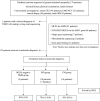Utilisation of exome sequencing for muscular disorders in Thai paediatric patients: diagnostic yield and mutational spectrum
- PMID: 36697461
- PMCID: PMC9876991
- DOI: 10.1038/s41598-023-28405-6
Utilisation of exome sequencing for muscular disorders in Thai paediatric patients: diagnostic yield and mutational spectrum
Abstract
Muscular dystrophies and congenital myopathies are heterogeneous groups of inherited muscular disorders. An accurate diagnosis is challenging due to their complex clinical presentations and genetic heterogeneity. This study aimed to determine the utilisation of exome sequencing (ES) for Thai paediatric patients with muscular disorders. Of 176 paediatric patients suspected of genetic/inherited myopathies, 133 patients received a molecular diagnosis after performing conventional investigations, single gene testing, and gene panels. The remaining 43 patients from 42 families could be classified into three groups: Group 1, MLPA-negative Duchenne muscular dystrophy (DMD) with 9 patients (9/43; 21%), Group 2, other muscular dystrophies (MD) with 18 patients (18/43; 42%) and Group 3, congenital myopathies (CM) with 16 patients (16/43; 37%). All underwent exome sequencing which could identify pathogenic variants in 8/9 (89%), 14/18 (78%), and 8/16 (50%), for each Group, respectively. Overall, the diagnostic yield of ES was 70% (30/43) and 36 pathogenic/likely pathogenic variants in 14 genes were identified. 18 variants have never been previously reported. Molecular diagnoses provided by ES changed management in 22/30 (73%) of the patients. Our study demonstrates the clinical utility and implications of ES in inherited myopathies.
© 2023. The Author(s).
Conflict of interest statement
The authors declare no competing interests.
Figures
Similar articles
-
Whole-Exome Sequencing Identifies Small Mutations in Pakistani Muscular Dystrophy Patients.Genet Test Mol Biomarkers. 2021 Mar;25(3):218-226. doi: 10.1089/gtmb.2020.0246. Genet Test Mol Biomarkers. 2021. PMID: 33734897
-
Diagnostic yield of exome sequencing in myopathies: Experience of a Slovenian tertiary centre.PLoS One. 2021 Jun 9;16(6):e0252953. doi: 10.1371/journal.pone.0252953. eCollection 2021. PLoS One. 2021. PMID: 34106991 Free PMC article.
-
Application of whole exome sequencing in the diagnosis of muscular disorders: a study of Taiwanese pediatric patients.Front Genet. 2024 May 15;15:1365729. doi: 10.3389/fgene.2024.1365729. eCollection 2024. Front Genet. 2024. PMID: 38818036 Free PMC article.
-
Identifying Non-Duchenne Muscular Dystrophy-Positive and False Negative Results in Prior Duchenne Muscular Dystrophy Newborn Screening Programs: A Review.JAMA Neurol. 2016 Jan;73(1):111-6. doi: 10.1001/jamaneurol.2015.3537. JAMA Neurol. 2016. PMID: 26594870 Review.
-
Update on Muscular Dystrophies with Focus on Novel Treatments and Biomarkers.Curr Neurol Neurosci Rep. 2020 May 14;20(6):14. doi: 10.1007/s11910-020-01034-6. Curr Neurol Neurosci Rep. 2020. PMID: 32409939 Review.
Cited by
-
Next-generation sequencing for pediatric-onset neuromuscular disorders unresolved by conventional diagnostic methods.Pediatr Res. 2025 Jun 10. doi: 10.1038/s41390-025-04160-4. Online ahead of print. Pediatr Res. 2025. PMID: 40494860
References
Publication types
MeSH terms
LinkOut - more resources
Full Text Sources
Medical



